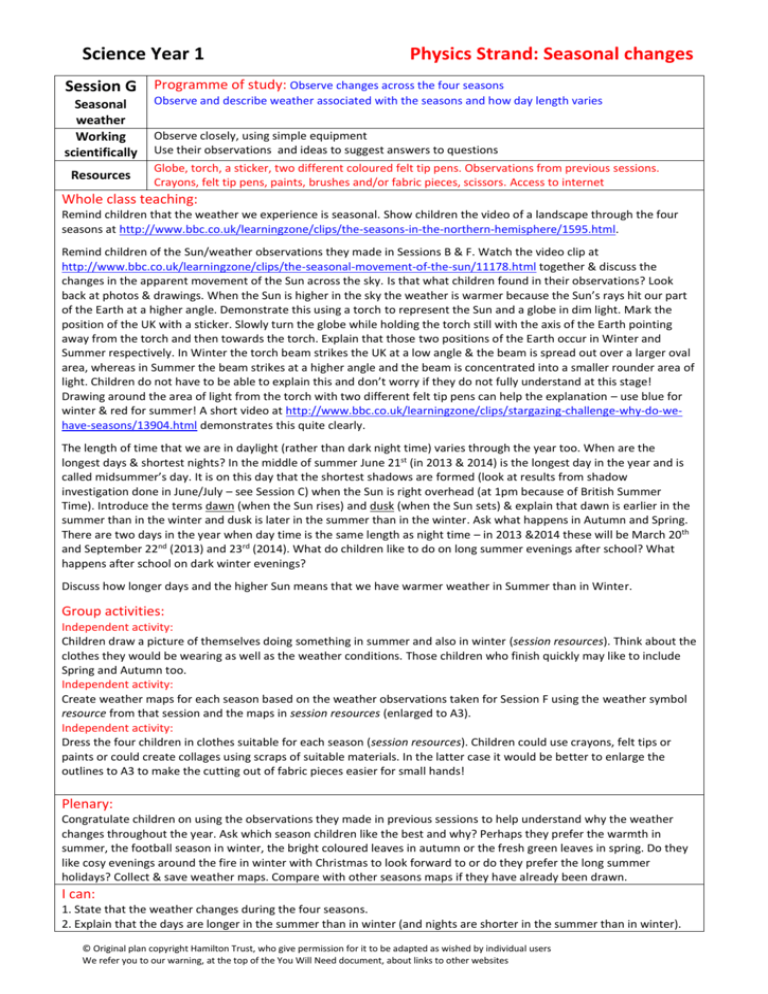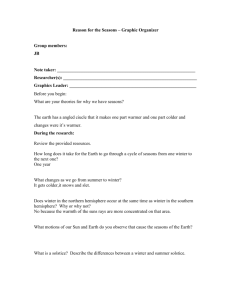Seasonal weather Session
advertisement

Science Year 1 Physics Strand: Seasonal changes Session G Programme of study: Observe changes across the four seasons Seasonal weather Working scientifically Resources Observe and describe weather associated with the seasons and how day length varies Observe closely, using simple equipment Use their observations and ideas to suggest answers to questions Globe, torch, a sticker, two different coloured felt tip pens. Observations from previous sessions. Crayons, felt tip pens, paints, brushes and/or fabric pieces, scissors. Access to internet Whole class teaching: Remind children that the weather we experience is seasonal. Show children the video of a landscape through the four seasons at http://www.bbc.co.uk/learningzone/clips/the-seasons-in-the-northern-hemisphere/1595.html. Remind children of the Sun/weather observations they made in Sessions B & F. Watch the video clip at http://www.bbc.co.uk/learningzone/clips/the-seasonal-movement-of-the-sun/11178.html together & discuss the changes in the apparent movement of the Sun across the sky. Is that what children found in their observations? Look back at photos & drawings. When the Sun is higher in the sky the weather is warmer because the Sun’s rays hit our part of the Earth at a higher angle. Demonstrate this using a torch to represent the Sun and a globe in dim light. Mark the position of the UK with a sticker. Slowly turn the globe while holding the torch still with the axis of the Earth pointing away from the torch and then towards the torch. Explain that those two positions of the Earth occur in Winter and Summer respectively. In Winter the torch beam strikes the UK at a low angle & the beam is spread out over a larger oval area, whereas in Summer the beam strikes at a higher angle and the beam is concentrated into a smaller rounder area of light. Children do not have to be able to explain this and don’t worry if they do not fully understand at this stage! Drawing around the area of light from the torch with two different felt tip pens can help the explanation – use blue for winter & red for summer! A short video at http://www.bbc.co.uk/learningzone/clips/stargazing-challenge-why-do-wehave-seasons/13904.html demonstrates this quite clearly. The length of time that we are in daylight (rather than dark night time) varies through the year too. When are the longest days & shortest nights? In the middle of summer June 21st (in 2013 & 2014) is the longest day in the year and is called midsummer’s day. It is on this day that the shortest shadows are formed (look at results from shadow investigation done in June/July – see Session C) when the Sun is right overhead (at 1pm because of British Summer Time). Introduce the terms dawn (when the Sun rises) and dusk (when the Sun sets) & explain that dawn is earlier in the summer than in the winter and dusk is later in the summer than in the winter. Ask what happens in Autumn and Spring. There are two days in the year when day time is the same length as night time – in 2013 &2014 these will be March 20th and September 22nd (2013) and 23rd (2014). What do children like to do on long summer evenings after school? What happens after school on dark winter evenings? Discuss how longer days and the higher Sun means that we have warmer weather in Summer than in Winter. Group activities: Independent activity: Children draw a picture of themselves doing something in summer and also in winter (session resources). Think about the clothes they would be wearing as well as the weather conditions. Those children who finish quickly may like to include Spring and Autumn too. Independent activity: Create weather maps for each season based on the weather observations taken for Session F using the weather symbol resource from that session and the maps in session resources (enlarged to A3). Independent activity: Dress the four children in clothes suitable for each season (session resources). Children could use crayons, felt tips or paints or could create collages using scraps of suitable materials. In the latter case it would be better to enlarge the outlines to A3 to make the cutting out of fabric pieces easier for small hands! Plenary: Congratulate children on using the observations they made in previous sessions to help understand why the weather changes throughout the year. Ask which season children like the best and why? Perhaps they prefer the warmth in summer, the football season in winter, the bright coloured leaves in autumn or the fresh green leaves in spring. Do they like cosy evenings around the fire in winter with Christmas to look forward to or do they prefer the long summer holidays? Collect & save weather maps. Compare with other seasons maps if they have already been drawn. I can: 1. State that the weather changes during the four seasons. 2. Explain that the days are longer in the summer than in winter (and nights are shorter in the summer than in winter). © Original plan copyright Hamilton Trust, who give permission for it to be adapted as wished by individual users We refer you to our warning, at the top of the You Will Need document, about links to other websites








